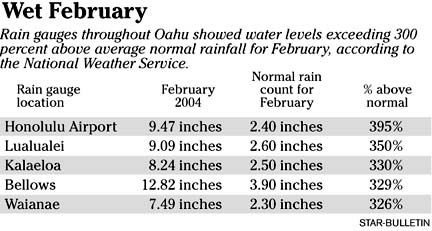
Isle farmers suffer after
recent heavy rains
The Nalo greens are on hold at Dean Okimoto's Waimanalo farm, victims of a series of pounding storms that blew down or washed away millions of dollars in isle crops.
"This last one was the worst," said Okimoto, who grows salad greens and herbs at Nalo Farms. "We haven't had any production of Nalo greens since that downpour."
Preliminary crop damage from the February thunderstorms was estimated at $1.5 million to $2 million, said state agricultural statistician Donald Martin.
"It could be higher, but there is not an exact estimate available," said Martin. "Sometimes, you don't know the effects until months later."
Okimoto said his farm was able to salvage some crops during the storms in December and January but not last month.
"This time, we weren't able to save anything. ... We lost as much if not more on this one rain," he said. Okimoto estimated a $300,000 income loss since December, more than double the amount he estimated in January.
"We're going to try to recover," he said, noting workers started to plow the grounds this week.
Hilary Brown, general manager of Mac Farms of Hawaii Inc., said the South Kona orchard lost 2,400 macadamia nut trees last month, more than triple the amount of trees destroyed in December.
Damage was estimated at almost $500,000 for the trees, each valued at $200.
"These trees were 12 years of age," said Brown. He estimated an additional $75,000 in crop loss for the year.
About 180 acres of sweet onions were washed away at Aloun Farms on the Ewa Plain, said general manager Alec Sou.
"We normally get 11 to 16 inches of rain at the Ewa Plain," he said. "Between mid-December and February, we probably got three times more than the normal amount of rain."
He estimated $800,000 worth of onions to be exported to the mainland had to be canceled.
Some areas posted 24-hour rainfall records during the February storms, according to the National Weather Service.
For Oahu, "most totals for the month of February were well above normal, including 15 sites above 200 percent of normal and five sites above 300 percent of normal," hydrologist Kevin Kodama said in a monthly precipitation report.
Honolulu Airport had 9.47 inches, the highest monthly total since November 1996.
Gauges in Lanai, Maui and the Big Island also showed rainfall at least double their normal level for the month of February.
The heavy rains had a slight effect at some of Oahu's wells, said Donna Kiyosaki, deputy manager of the Board of Water Supply in Honolulu.
"People think that because of the heavy rains that it will recover. It does take time," said Kiyosaki, noting Oahu has had six years of dry weather.
She noted that heavy rains help water usage remain low because less water is pumped. But most of the water from heavy rains runs off into the ocean and "it doesn't have a chance to recharge the groundwater aquifers."
"The best kind of rain is the steady mist, lighter rains," said Kiyosaki.
